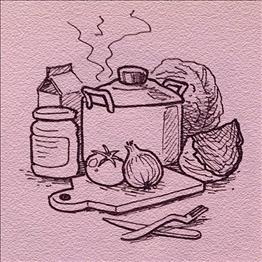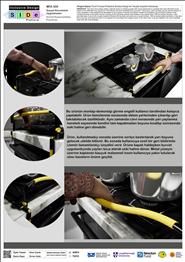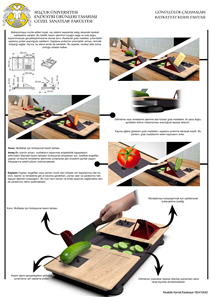Loading
Protective Surface in Kitchen

DESIGNED BY:
Öykü Yüksel, Onur Çevik, Deniz Kaya, Evren Usta, Abdurrahman Çakır (SDFB)
PROTECTIVE SURFACE PROJECT:
“Kitchen” is one of the spaces where we spend most of our time during our everyday lives, and where accessibility affects our interaction with many products and its areas. Within the scope of this project, we focused on the problems faced by persons with visual disabilities in kitchens and collaborated with the Six Dots Foundation for the Blinds throughout the process. During the project, support from the NGO design partner was taken to roll out solutions for accessibility issues faced by persons with visual disabilities in the kitchen. With this purpose in mind, the habits of persons with visual disabilities in the kitchen were first observed, common problems were detected, and suggestions were made to overcome these problems. In the first stage, the general tasks performed in the kitchen (cooking, storage, preparation, etc.) were studied, and many problems related to the interaction of persons with visual disabilities with the kitchen space were explored. The difficulties identified are listed below:
As can be seen, the problems in the kitchen have been extensively explored in line with the discussions held with the design partner. After initial the study, solution areas were identified where the design activity could be directed and these areas were again further discussed with the design partner to carry out the possible conceptual work. The possible solution areas identified were as follow:
As a result of all this research carried out and the possible solutions identified, we aimed to provide the maximum number of benefits by using a minimum number of pieces. In addition to these, a consensus was reached with the NGO partner after meetings on the direction of the design work, which focussed on providing solutions to problems like oil splashes, issues regarding controlling the cooking items on the hob, and risks of hitting to the protruded parts of kitchen objects. Based on these problems that persons with visual disabilities experience in their kitchens, a product was designed, enabling them to complete their work with fewer risks.
“PROTECTIVE SURFACE”:
“Protective Surface” aims at preventing problems with the hob in line with the issues listed above, so that a safe interaction between persons with visual disabilities and the hob can be obtained. The persons with visual disabilities can easily do the assembly and disassembly of this product. The product can be easily removed from its joints for cleaning purpose, and then can be attached back again without assistance. At the same time, thanks to its semi-spring movement, it can return to its former state when the height is reduced to half by pressing over it from its top. The product can be locked at half of its length in this way, and in the meantime, it gives audio feedback to the user that it is locked. When pressed over the product again, the springs are released, and the protective surface returns to its original height. The rubber material covering the metal surface is kept close to the user to prevent possible accidents. With this feature, the user’s hand has also been kept away from the heat zone.
Öykü Yüksel, Onur Çevik, Deniz Kaya, Evren Usta, Abdurrahman Çakır (SDFB)
PROTECTIVE SURFACE PROJECT:
“Kitchen” is one of the spaces where we spend most of our time during our everyday lives, and where accessibility affects our interaction with many products and its areas. Within the scope of this project, we focused on the problems faced by persons with visual disabilities in kitchens and collaborated with the Six Dots Foundation for the Blinds throughout the process. During the project, support from the NGO design partner was taken to roll out solutions for accessibility issues faced by persons with visual disabilities in the kitchen. With this purpose in mind, the habits of persons with visual disabilities in the kitchen were first observed, common problems were detected, and suggestions were made to overcome these problems. In the first stage, the general tasks performed in the kitchen (cooking, storage, preparation, etc.) were studied, and many problems related to the interaction of persons with visual disabilities with the kitchen space were explored. The difficulties identified are listed below:
- Problems in the correct placement of the pots on the stove,
- Possible hazards due to getting caught on pots’ protruded handles,
- The risk of hitting the open doors of white goods (such as dishwashers) or the doors of upper cabinets accidentally,
- The preference of hand-level storage areas due to the problems encountered in using upper cabinets,
- The problems occurred when the cabinet handles are too protruding, which result in users’ hit or their clothes caught,
- Possibility of hazards due to oil splashes,
- The risks of overflow when serving juicy dishes,
- The risks encountered in the process of chopping, cutting and similar tasks done with sharp knives,
- Difficulties encountered during the removal of food from the cutting board,
- Difficulties in understanding the decay of fruits and vegetables or spoilage in products,
- Difficulties encountered when in need of objects/products whose places have been changed involuntarily.
As can be seen, the problems in the kitchen have been extensively explored in line with the discussions held with the design partner. After initial the study, solution areas were identified where the design activity could be directed and these areas were again further discussed with the design partner to carry out the possible conceptual work. The possible solution areas identified were as follow:
- Trying different forms in handle systems to prevent accidents,
- A solution to make the upper cabinet doors risk-free,
- Possible solutions to increase the use of hand-level areas and/or lower cabinets for storage,
- Solutions for the feedback of electronic products that remain switched on for a long time,
- Solutions on increasing the accessibility of cutlery (knives, scissors, wooden spoons, etc.) with a focus on their placement, organisation, and functional grouping in the kitchen.
- Solutions for the problems that arise when placing the pots on the hob and oil splashes while cooking,
- A solution to create possible working areas in the form of a tray that can also be used together with deep containers or which could combine the two.
As a result of all this research carried out and the possible solutions identified, we aimed to provide the maximum number of benefits by using a minimum number of pieces. In addition to these, a consensus was reached with the NGO partner after meetings on the direction of the design work, which focussed on providing solutions to problems like oil splashes, issues regarding controlling the cooking items on the hob, and risks of hitting to the protruded parts of kitchen objects. Based on these problems that persons with visual disabilities experience in their kitchens, a product was designed, enabling them to complete their work with fewer risks.
“PROTECTIVE SURFACE”:
“Protective Surface” aims at preventing problems with the hob in line with the issues listed above, so that a safe interaction between persons with visual disabilities and the hob can be obtained. The persons with visual disabilities can easily do the assembly and disassembly of this product. The product can be easily removed from its joints for cleaning purpose, and then can be attached back again without assistance. At the same time, thanks to its semi-spring movement, it can return to its former state when the height is reduced to half by pressing over it from its top. The product can be locked at half of its length in this way, and in the meantime, it gives audio feedback to the user that it is locked. When pressed over the product again, the springs are released, and the protective surface returns to its original height. The rubber material covering the metal surface is kept close to the user to prevent possible accidents. With this feature, the user’s hand has also been kept away from the heat zone.
Please login to post comments

